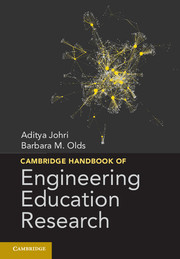Book contents
- Frontmatter
- Dedication
- Contents
- Editors
- Contributors
- Foreword
- Acknowledgments
- Introduction
- Chapter 1 Chronological and Ontological Development of Engineering Education as a Field of Scientific Inquiry
- Part 1 Engineering Thinking and Knowing
- Part 2 Engineering Learning Mechanisms and Approaches
- Part 3 Pathways into Diversity and Inclusiveness
- Chapter 14 Engineering Identity
- Chapter 15 Studying the Career Pathways of Engineers
- Chapter 16 Retention and Persistence of Women and Minorities Along the Engineering Pathway in the United States
- Chapter 17 Social Justice and Inclusion
- Chapter 18 Community Engagement in Engineering Education as a Way to Increase Inclusiveness
- Part 4 Engineering Education and Institutional Practices
- Part 5 Research Methods and Assessment
- Part 6 Cross-Cutting Issues and Perspectives
- Index
- References
Chapter 17 - Social Justice and Inclusion
Women and Minorities in Engineering
Published online by Cambridge University Press: 05 February 2015
- Frontmatter
- Dedication
- Contents
- Editors
- Contributors
- Foreword
- Acknowledgments
- Introduction
- Chapter 1 Chronological and Ontological Development of Engineering Education as a Field of Scientific Inquiry
- Part 1 Engineering Thinking and Knowing
- Part 2 Engineering Learning Mechanisms and Approaches
- Part 3 Pathways into Diversity and Inclusiveness
- Chapter 14 Engineering Identity
- Chapter 15 Studying the Career Pathways of Engineers
- Chapter 16 Retention and Persistence of Women and Minorities Along the Engineering Pathway in the United States
- Chapter 17 Social Justice and Inclusion
- Chapter 18 Community Engagement in Engineering Education as a Way to Increase Inclusiveness
- Part 4 Engineering Education and Institutional Practices
- Part 5 Research Methods and Assessment
- Part 6 Cross-Cutting Issues and Perspectives
- Index
- References
Summary
Introduction
Evelynn Hammonds (1994) made a field-shaping move in her essay “Black (W)holes and the geometry of Black female sexuality (More Gender Trouble: Feminism Meets Queer Theory).” Her piece was part of a special issue on queer theory in the journal differences, the second that journal had produced. She describes her experience of picking up the journal's first issue on queer theory, as well as the Gay and Lesbian Studies Reader, looking for articles that reflected in some way her experience. She notes that even when writers of color were included, “the text displays the consistently exclusionary practices of lesbian and gay studies in general. In my reading, the canonical terms and categories of the field…are stripped of context in the works of those theorizing about these very categories, identities, and subject positions. Each of these terms is defined with white as the normative state of existence” (127–128). She goes on to note the lack of reflexivity among queer theorists, who did not examine intersectional categories of difference in their own work. The theorists’ engagement with inequity, although not necessarily insincere, nonetheless stopped short of questioning the structural conditions in which the theorists themselves gained intellectual credence and other forms of cultural privilege.
What can the field of engineering education learn from this critical moment in queer theory? We seek to emulate Hammonds's process in this chapter, which explores how the engineering education community tends to take up issues of diversity. In engineering, efforts to expand participation in the field have hewed to concerns that are well intentioned, but like the queer theorists’ approach, somewhat lacking in reflexivity and self-limiting in their impacts. After years of struggle, so far engineering has come to include women and [racial and ethnic] minorities to a certain extent (albeit treated as two separate categories, largely ignoring the intersection). Queerness, class, nationality, disability, age, and other forms of difference are for the most part not seen as requiring address. The focus has been on expanding the roster of who is present, using only those categories and methods familiar from decades of educational policy and practice. That is, we customarily count women and people of color, and measure gains or losses in numeric representation of those groups, as programs to end discrimination in education, recruiting, hiring, and promotion have been put into practice.
- Type
- Chapter
- Information
- Cambridge Handbook of Engineering Education Research , pp. 335 - 356Publisher: Cambridge University PressPrint publication year: 2014
References
- 45
- Cited by

